Family recipe for apricot dumplings made with an easy potato dough. They are fruity, low in added sugar, yet still sweet and so juicy and delicious!
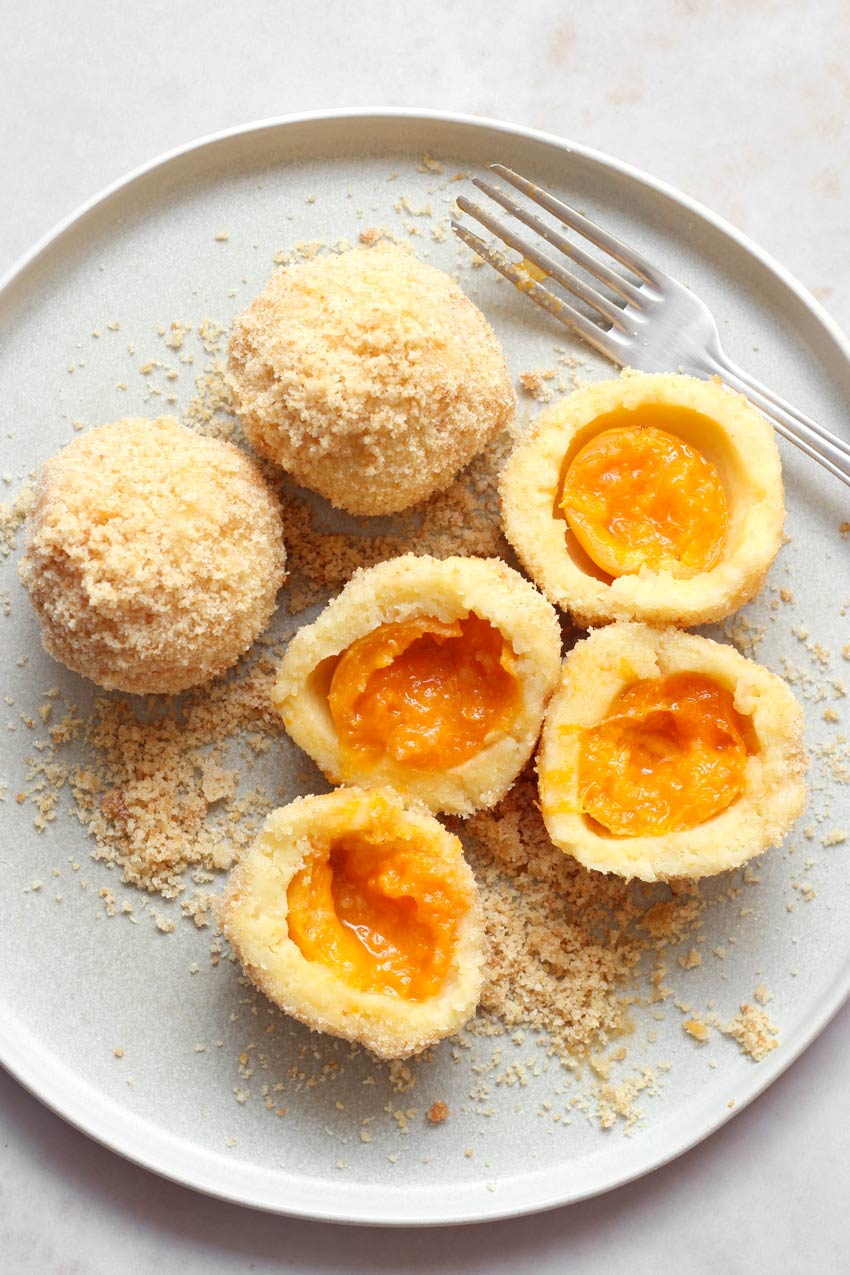
Sweet main dish or dessert
Traditional Austrian apricot dumplings are one of my dearest recipes in summer. For this family recipe I wrap fresh apricots in potato dough, cook them, and serve with buttery toasted breadcrumbs. Simply delicious!
I love to eat them as a sweet main dish (as it is tradition here in Austria) or as dessert. The apricot in the center gets soft and juicy during cooking and potato dough is just perfect to soak up the sweet juices. The buttery toasted breadcrumbs are the perfect finish, and a sprinkle of powdered sugar on top is always a great idea.
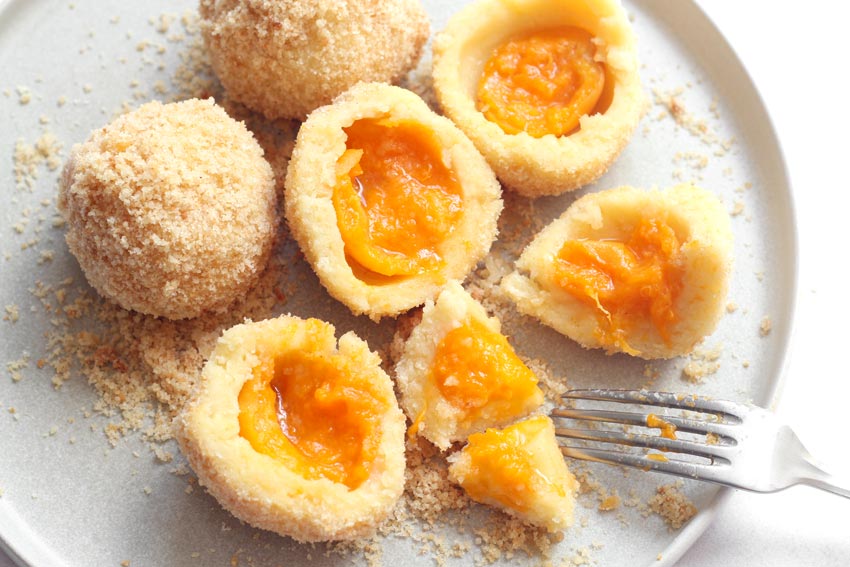
Apricot dumplings with potato or cheese dough
Austrians use mainly two different kind of doughs to make apricot dumplings: potato dough or curd cheese dough. Both are traditional, authentic choices.
I have already posted a recipe for apricot dumplings made with curd cheese dough (I use farmer’s cheese aka Topfen). But I know that sometimes it’s hard to find this kind of cheese outside of Europe so here is a second option to make these dumplings. They are just too delicious to miss out on them.
I make the dough with freshly riced or grated potatoes, which gives the dumplings a wonderful subtle potato taste that pairs well with hot apricots.
The dough is pretty similar to gnocchi dough, which is why you could use leftover dough to make gnocchi, especially if making a double batch. I always prepare enough dough to make apricot dumplings AND gnocchi :)
By the way: In late summer and fall, I use this dough to make plum dumplings.
So today, I am proudly presenting the recipe for apricot dumplings made with potato dough, which is a classic during the summer months.
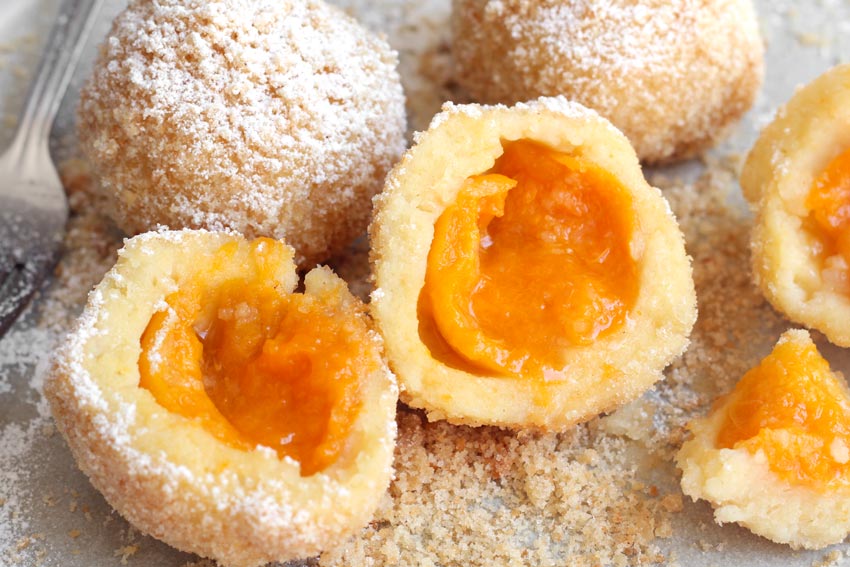
Step-by-step recipe apricot dumplings
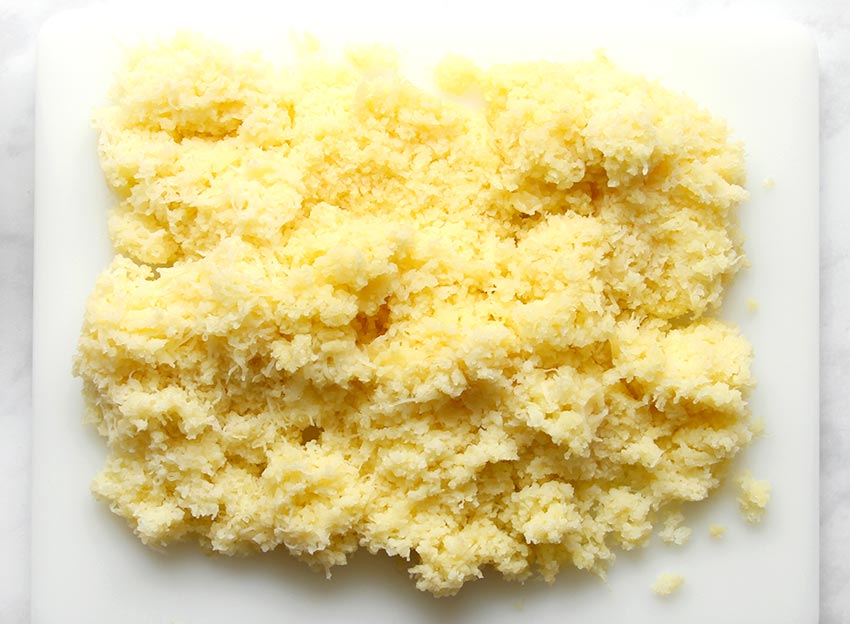
We start with making the potato dough. First, boil the potatoes until fork tender, about 25-30 minutes. When cool enough to handle, peel them and process through a ricer. If you don’t have a ricer, grate them using the small holes of a box grater.
Make sure there are no potato chunks left since they make shaping the dough difficult. Let the riced/grated potatoes cool.
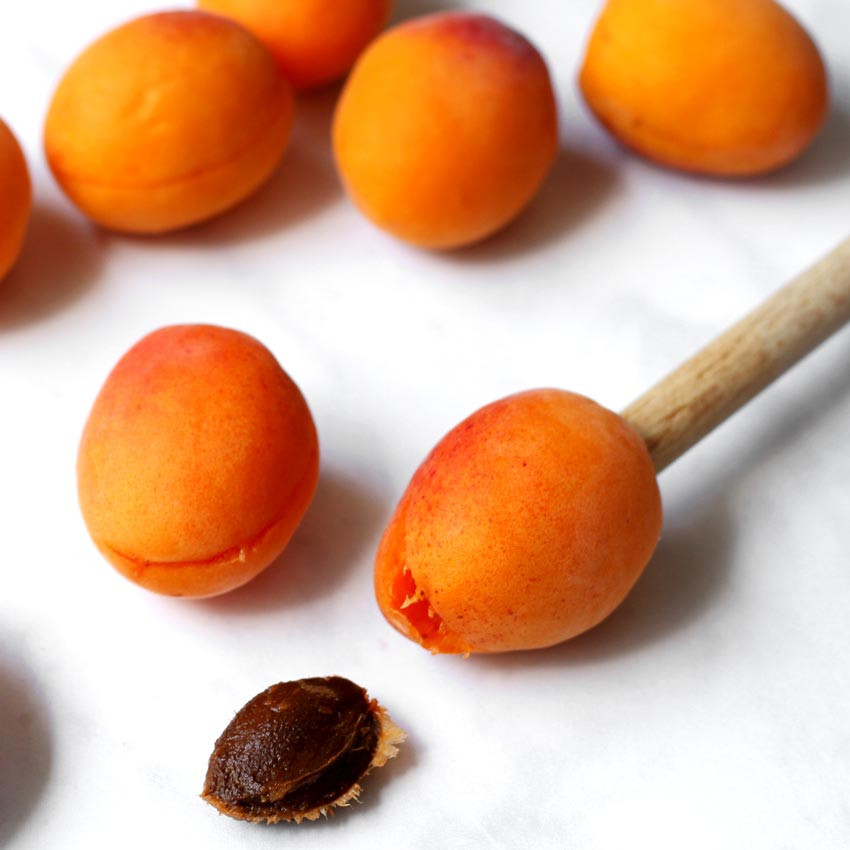
While the potatoes are cooling, wash the apricots and pat them dry. You can fill the dumplings with whole apricots (with stone), pitted, or pitted and filled with sugar – see note. I usually just pit them. If you want to fill the apricot with sugar, do so later or the sugar will dissolve.
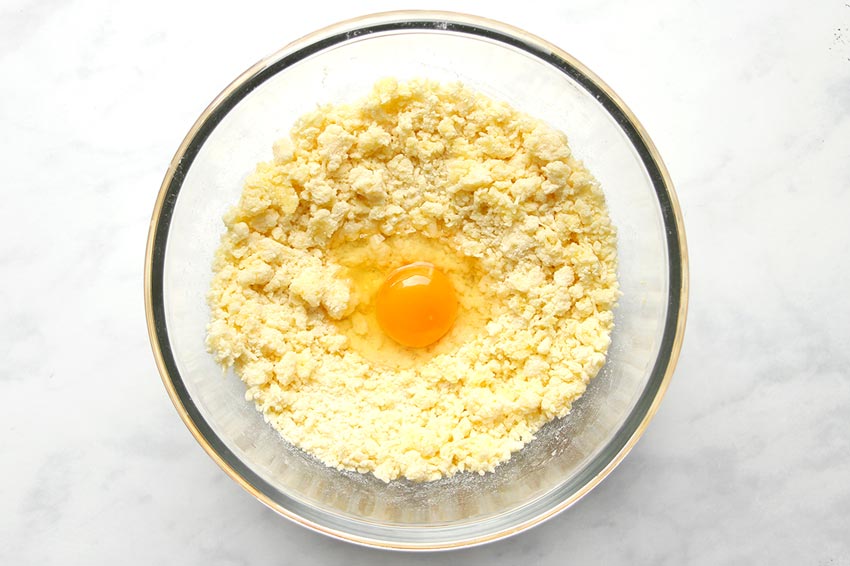
Once the grated potatoes are cooled, put them in a large bowl. Sprinkle with salt and butter, then add flour and semolina. Stir until most of the flour is worked in. Add the egg and incorporate with a fork.
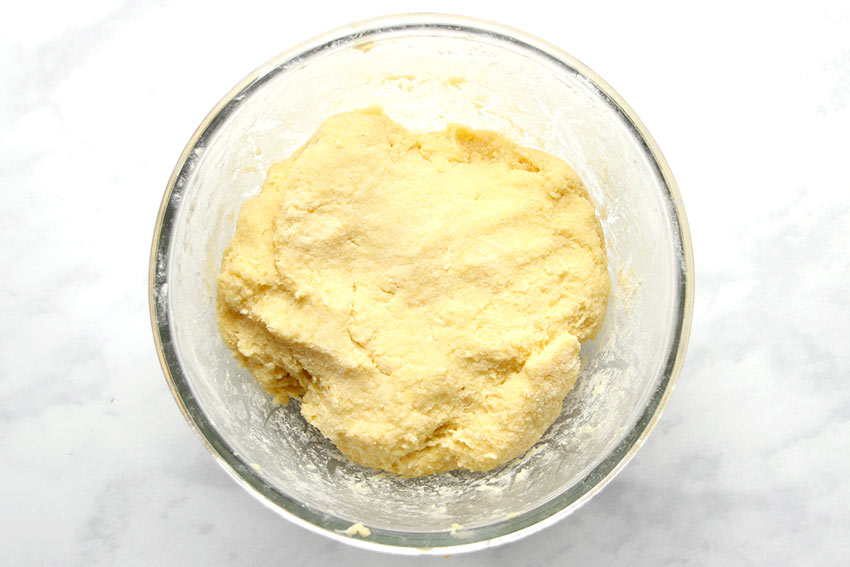
Briefly knead the dough until the ingredients stick together and form a dough (do not overwork it). The dough will be sticky.
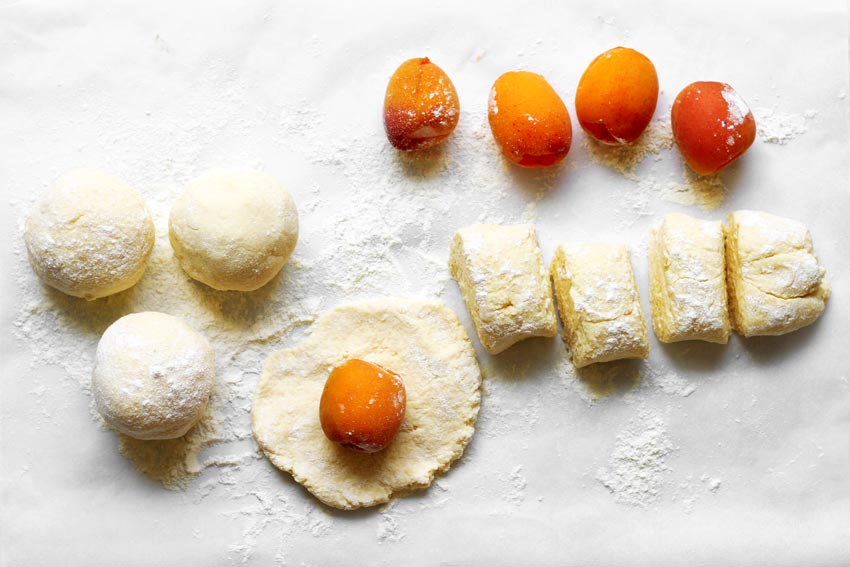
Now it’s time to shape the dumplings. Divide the dough into 10 portions on a well-floured surface. Flatten each portion to a round with well-floured hands and place an apricot in the center. Place a sugar cube in the apricot if desired. More on that in the recipe card below.
Tightly wrap the dough around the apricot, sealing the edges and shaping it into a ball. If the edge isn’t sticking since you used too much flour, dip your finger in water and wet the edge to close the dough around the plum.
Make sure you don’t trap any air inside or the dumpling will not sink to the bottom of the pot as it is supposed to but will float from the beginning. (No worries if it happens anyways, but it’s better if they are sinking down since the dough is cooked properly and the chance of bursting is lower.) If you like, you could freeze the dumplings now (see notes).
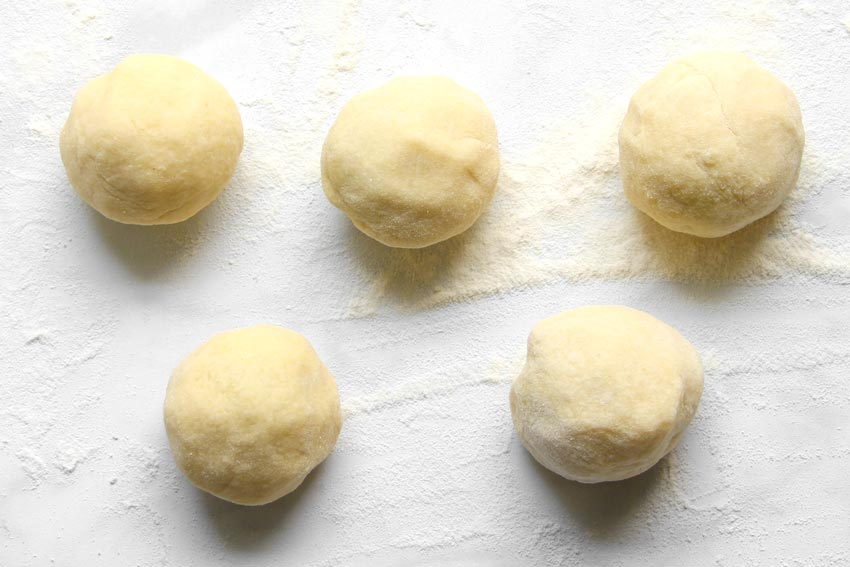
The shaped dumplings should look like in the photo above.
Cook apricot dumplings in a large pot with salted, slightly simmering water (no rolling boil) for about 12-15 minutes. The dumplings should float towards the end of the cooking time.
Make sure that they do not stick to the bottom of the pot. Gently stir with a spoon in case. In the meantime, make the breadcrumbs.
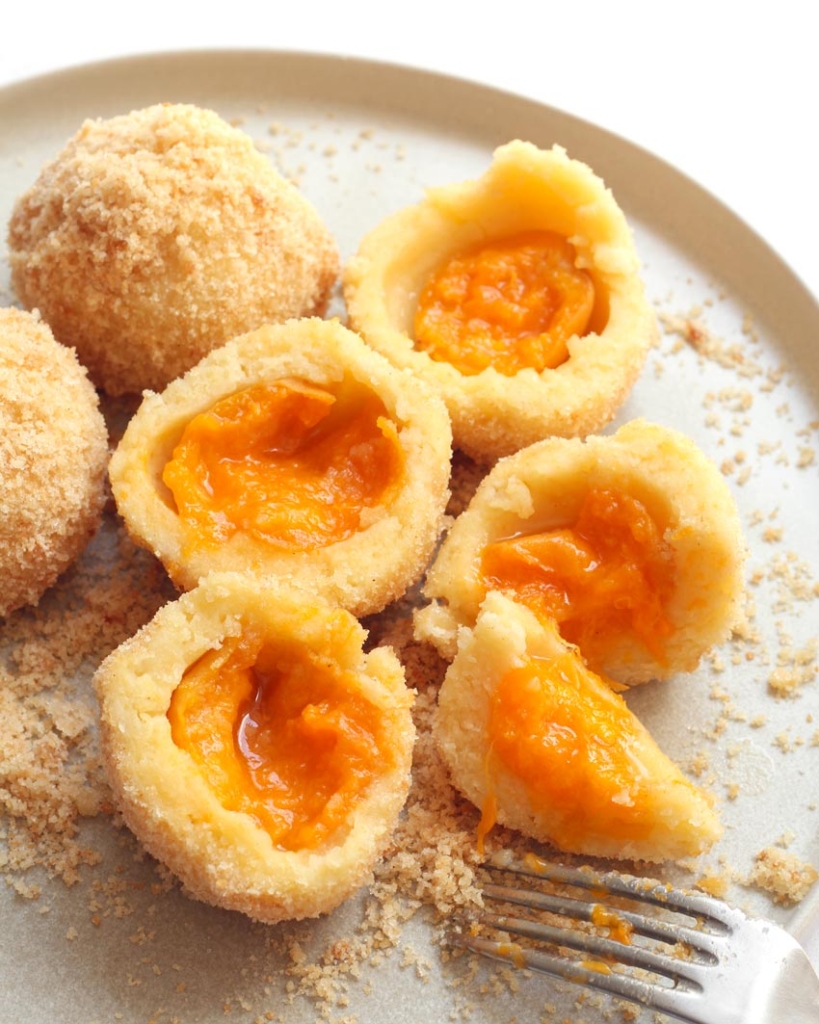
For making the breadcrumbs, melt the butter in a large pan, then add the breadcrumbs. Stir well for a few minutes over medium heat until the breadcrumbs are slightly darker and smell nicely.
Stir in sugar and cinnamon. Remove pan from the heat and keep an eye on the breadcrumbs because the residual heat can burn them easily (stir regularly).
Remove the cooked dumplings with a slotted spoon and transfer them to the pan with the breadcrumbs. Roll the dumplings in the crumbs until coated. Dust them with confectioners’ sugar if desired and serve immediately. Enjoy!
My favorite apricot recipes:
My favorite dumpling recipes:
Have you made these apricot dumplings? Let me know how they turned out in the comments below.
Apricot Dumplings with Potato Dough
Ingredients
For the apricot dumplings:
- 500 g (1.1 pounds) potatoes (like Russet, see note)
- 10 ripe, smallish apricots (see note)
- Optional: 10 sugar cubes or 2 tablespoons granulated sugar for filling the apricots (see note)
- 1 cup (125 g) all-purpose flour
- 3 tablespoons (37 g) wheat semolina (= cream of wheat or wheat farina; alternatively more ap-flour)
- 1/4 teaspoon fine salt
- 1 tablespoon butter, melted
- 1 large egg
For the toasted breadcrumbs:
- 3 tablespoons (42 g) unsalted butter
- 1 cup (100 g) plain, fine dry breadcrumbs
- 2 tablespoons (30 g) granulated sugar
- 1/4 teaspoon cinnamon
- Powdered sugar for dusting (optional)
Instructions
- Cook potatoes: Boil the potatoes until fork tender, about 25-30 minutes. When cool enough to handle, peel them and process through a ricer. If you don’t have a ricer, grate them using the small holes of a box grater. Make sure there are no potato chunks left since they make shaping the dough difficult. Let the riced/grated potatoes cool.
- Prepare apricots: Meanwhile, wash the apricots and pat them dry. You can fill the dumplings with whole apricots (with stone), pitted, or pitted and filled with sugar – see note. I usually just pit them. If filling the apricot with sugar, do so later or the sugar will dissolve.
- Make the dough: Put cooled, grated potatoes in a large bowl. Sprinkle with salt and butter, then add flour and semolina. Stir until most of the flour is worked in. Add the egg and incorporate with a fork, then briefly knead the dough until the ingredients stick together and form a dough (do not overwork it). The dough will be sticky.
- Make dumplings: Divide the dough into 10 portions on a well-floured surface. Flatten each portion to a round with well-floured hands and place an apricot in the center. Place a sugar cube in the apricot if desired.Tightly wrap the dough around the apricot, sealing the edges and shaping it into a ball. If the edge isn’t sticking since you used too much flour, dip your finger in water and wet the edge to close the dough around the plum. Make sure you don’t trap any air inside or the dumpling will not sink to the bottom of the pot as it is supposed to but will float from the beginning. (No worries if it happens anyways, but it’s better if they are sinking down since the dough is cooked properly and the chance of bursting is lower.) If you like, you could freeze the dumplings now (see notes).
- Cook dumplings: Cook apricot dumplings in a large pot with salted, slightly simmering water (no rolling boil) for about 12-15 minutes. The dumplings should float towards the end of the cooking time. Make sure that they do not stick to the bottom of the pot. Gently stir with a spoon in case. In the meantime, make the breadcrumbs.
- Make toasted breadcrumbs: In a large pan, melt the butter, add the breadcrumbs. Stir well for a few minutes over medium heat until the breadcrumbs are slightly darker and smell nicely. Stir in sugar and cinnamon. Remove pan from the heat and keep an eye on the breadcrumbs because the residual heat can burn them easily (stir regularly).
- Roll dumplings in crumbs: Remove the cooked dumplings with a slotted spoon and transfer them to the pan with the breadcrumbs. Roll the dumplings in the crumbs until coated. Dust them with confectioners’ sugar if desired and serve immediately. Enjoy!
- If you have leftovers, store the dumplings in an airtight container in the fridge. They will keep for up to 3 days.
Notes
- Whole apricots: The wrapping of the dough around the apricots will be easiest if the stones are not removed. Simply warn your guests that there is a stone inside when serving.
- Pitted apricots: It’s easiest to pit apricots by inserting the back of a cooking spoon from one side (where the stem is) and pushing it out the other way. Alternatively, slice them half open with a knife and remove the pit.
- Pitted, sugar-filled: Pit them as directed above, then replace the apricot stone with a sugar cube. This will make a nice syrupy center. If you don’t have any sugar cubes on hand, use about 1/2 teaspoon granulated sugar. If doing so, slice the apricot with a knife until half open because the hole from pitting them with a cooking spoon will be too small. If you decide to fill them with sugar, only do so right before wrapping with dough. The longer the apricots sit with the sugar filling, the more sugar will dissolve, which makes the wrapping messy and difficult.
- For my extra-special version: Briefly soak the sugar cube with amaretto liqueur before filling the apricot.
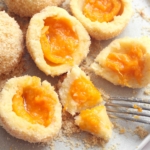
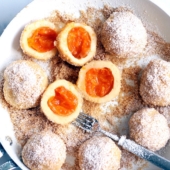

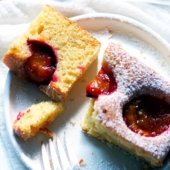
Hallo von Kanada,
Hatte heute morgen ueberlegt Zwetschkenknoedel zu machen und siehe da, alles im Briefkasten.
You are doing such a good job, and Austrian’s kitchen is just the best for these kinds of goodies….
Thank you dearly,
Dorothea
I am Austrian, living in Kanada, and known here for my Austrian Cuisine!
Hi Dorothea,
Danke :)
Zwetschgenknödel (https://www.lilvienna.com/plum-dumplings/) and apricot dumplings are my favorite. Happy to hear that you were thinking about making plum dumplings. I bet you are famous for your Austrian Schmankerln :)
Thanks for your comment, Dorothea!
Ursula
My husband was born in Austria, and his mother makes these once a year as a family treat here in Australia. She is now in her late 80’s and whilst I help each year she can never explain quantities. She just throws everything in a big plastic tub. After finding your recipe I have been brave enough to give them a go myself. Thank you, they turned out absolutely delicious and dare I say better than “Mutters” as she never riced or grated the potato and they were always a bit lumpy. Thank you for sharing this recipe.
Hi Kim,
So happy to hear that the potato dumplings come out so well. What a compliment ‘better than Mutters’ haha. Yes, it makes a big difference to use riced/grated potatoes. They are more even and the dough is not lumpy at all. So the next time, you can make the dumplings for your mother in law. I bet she will be delighted (or I hope hehe).
Ursula
Loved them when I visited Vienna on our 20 years anniversary , loved cooking them using the recipe above .
Hi Harry,
the best anniversary gift – in my opinion :) So happy that you were able to make and enjoy them!
Very informative and to the point. Thanks for all the step photos and explanations. We all love knoedel.
Hi H.,
Happy you found what you were looking for. I hope that you’ll give them a try :)
Ursula